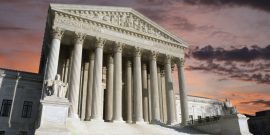A precedent-only jurisprudence will be not driven by the inner logic of the Constitution, but varying coalitions of the justices and politics of the day.
Salinas, Griffin, and The Oddness of The Original Criminal Procedure
There has recently been some significant discussion of Justice Thomas’s concurring opinion (joined by Justice Scalia) in Salinas. See here and here and here. In his Salinas concurrence, Justice Thomas argued that the doctrine announced in Griffin v. California – that the privilege against self incrimination barred a prosecutor or judge from commenting on the fact that the criminal defendant did not testify at trial– was not in accord with the Constitution’s original meaning. Thomas also argued that the doctrine should not be extended in Salinas to comments on the criminal defendant’s precustodial silence.
What is interesting about this issue is that when one looks at the originalist history, one finds entirely different practices than those of the modern courts. It is often said that the purpose of the privilege against self incrimination was to prevent the government from forcing individuals to testify against themselves. And so it probably was. Some courts such as the Star Chamber would require that the defendant provide such testimony.
But in the common law courts, the practice was different. True, defendants were not compelled to testify against themselves, but in part the reason was that defendants could not testify under oath at all. They were barred from so testifying. As Justice Scalia wrote in Mitchell v. US:
The question whether a factfinder may draw a logical inference from a criminal defendant’s failure to offer formal testimony would not have arisen in 1791, because common-law evidentiary rules prevented a criminal defendant from testifying in his own behalf even if he wanted to do so. . . . That is not to say, however, that a criminal defendant was not allowed to speak in his own behalf, and a tradition of expecting the defendant to do so, and of drawing an adverse inference when he did not, strongly suggests that Griffin is out of sync with the historical understanding of the Fifth Amendment. Traditionally, defendants were expected to speak rather extensively at both the pretrial and trial stages of a criminal proceeding. The longstanding common-law principle, nemo tenetur seipsum prodere, was thought to ban only testimony forced by compulsory oath or physical torture, not voluntary, unsworn testimony. See T. Barlow, The Justice of Peace: A Treatise Containing the Power and Duty of That Magistrate 189—190 (1745). . . .
At trial, defendants were expected to speak directly to the jury. Sir James Stephen described 17th- and 18th-century English trials as follows:
“[T]he prisoner in cases of felony could not be defended by counsel, and had therefore to speak for himself. He was thus unable to say…that his mouth was closed. On the contrary his mouth was not only open, but the evidence given against him operated as so much indirect questioning, and if he omitted to answer the questions it suggested he was very likely to be convicted.” J. Stephen, 1 History of the Criminal Law of England 440 (1883).
Significantly, the inability of defendants to testify under oath was not changed until many years later. The first state to do so was Maine in 1864, with “the rest of the States and Federal Government eventually” following.
Despite this difference in practice, Justices Scalia and Thomas make a persuasive case for concluding that the original meaning of the privilege against self incrimination does not bar comments by the prosecutor or judge that the defendant has not testified – at least given my relatively untutored understanding of originalist criminal procedure.
Still, what is striking is how different criminal procedure was at the time of the framing. It is said that the past is another country and that is certainly true with respect to criminal procedure. In addition to defendants being allowed to testify under oath, there was also the fact (as referred to above) that criminal defendants in England and in some of the colonies were not permitted to be represented by defense attorneys. Of course, that was changed by the Sixth Amendment, but apparently a large number of criminal defendants still represented themselves.
There were other very significant differences. To mention just a couple, there was a common practice of private prosecution of criminal law, there was no police force of the type we are familiar with, and there were essentially no penitentiaries (with jail being used as a “nonpunitive detention facility”).
As is the case with self incrimination, these differences do not necessarily mean that the original meaning cannot be uncovered. But they do make it harder.

